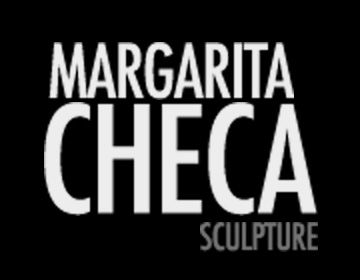GRAINS OF INSPIRATION
By Josefina Barrón
“The Warrior.” This is what Margarita Checa has named one her most beautiful pieces. That is how she appears, when, chainsaw in hand, she pierces the uncertain skin of the wood, discovers its innards and battles with knots, irregular grains and cries, with the tenacity that motivates those who strive for perfection. And nobody will stop her.
Margarita is one of the most prestigious sculptors Peru has. This was reason enough to pay her a visit. She received me somewhat cautiously, though with rising smile in her eyes, surrounded by her dogs and her tree trunks, in her studio on Villa El Salvador. Obviously, I only had to enter and breathe deeply to feel the permeating aroma of olive wood. It took a moment, given the stench given off by clandestine pigsties that flank the studio, but I soon felt myself submerged as in a sea of enormous tunas.
Like other several other stand-out artists of her generation, Margarita was a student of Ana Macagno and Christina Galvez. I wanted to know at some point it had made her uncomfortable that the figure of Christina constantly appears relative to her work: “When I was registering for her workshop, someone suggested that I shouldn’t do it, because she was very dominant and I could end up being absorbed. And what am I, a sheep?! Nooo, Christina showed me so much, I might not be where I am if she had not pushed me in difficult moments, but she is one and I am another.” We are in agreement, I think. In matters of creation, everyone follows their own North Star. Hers is to convert enormous Olive trunks into beings that capture the human essence, silent figures, secluded, something apart, absolutely beyond the mundane noise of the city.
ONLY ONE WORLD
Her sculptures seem to evoke myths and legends of some lost civilization, some African tribe. “No,” she replies roundly, “the stimulus is basically pre-Columbian.” Wasn’t it Campbell who wrote that all myths are connected to each other, though they come from distinct places and times? Well, yes, and it is that they responded to the same universal needs we all have to understand reality in all its magnitude. In other words, we are all human beings.
To reinforce the pre-Columbian link, Margarita shows me something significant to her: a cochimilco [a type of small figurine]. But it is not a little Chancay man so familiar to our eyes to the point of being shamelessly reproduced for sloe on some streets of the city. No, this figure, apart from other singular characteristics, has drawn on the back several fishes and shows a bold black and white design all over the body. Margarita told me that it was from this inspiration she began to apply to her statues inlays, brocades and incrustations of wood and bull’s horn, wanting to recreate this contrast.
Later came her stay in Costa Rica, and the contrast was seen more rapidly. Woods of various colors were available and she hasn’t forgotten being in a Costa Rican street in front of a truck loaded with a trunk so big it nearly it was nearly too wide for the mill. “That’s how the trees were in Costa Rica.” And she sighs.
Now returned, Margarita established herself in Ica and continued working in olive wood which, with the help of her brother Manuel, she saved from being converted.
She will never forget arriving at Llanca and having to witness the spectacle. They had felled a significant portion of the forest of olives, and were making them, literally, into firewood. She carried off everything that lay on the floor with a lump in her throat and in her heart. “And why olive?” I ask. “Because it is a wood that acquires the smoothness of skin; because, without looking, its grain is always in harmony with its size; and, of course, for the aroma.”
DESERTS AND CAROBS
Margarita spent most of her childhood in the North, among deserts and carobs, playing at giving form to the river, the night, the sun and the stars. It was only when she attempted to give form to time that she stopped playing that game, though not consciously. “Its funny,” she confesses, “sometimes I think I’m still playing the same game, trying to give form to everything. I believe deep down I chasing a chimera.”
Then, the peasants of the Checa hacienda went barefoot in the fields. Margarita doesn’t forget the stout feet that seemed to sprout from the very earth. From that memory come the stout feet of her women. From there her profound relationship with nature, her own feet on the earth.
The feminine figure is one of the constants on her work. Women who startle us with their slenderness and exuberance, through which the sculptor doesn’t necessarily intend to surprise, but to promote reflection. In them we see solitude, maternity, sorrow, sensuality and meditation. “I cannot separate myself from my feminine condition; I feel it is my self-portrait in my sculpture.”
Margarita admits having lost fear: “To be an artist one must have courage, above all in an environment like ours, in which everyone watches out for themselves.” And she shows me what she calls “battle wounds,” scars the chisel, saw, hammer, or God knows which of the other tools she pulls out like a magician pulls scarves out of a hat, have left on her body. “My children amaze me with the chainsaw at eighty, but I know I have little time left with that, so that I’m installing my foundry in the workshop. What will be mine, from her in a few years, will be bronze.”
Back